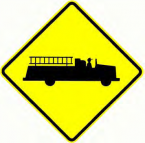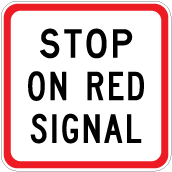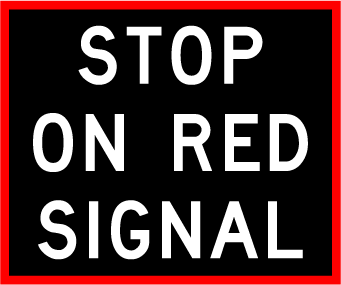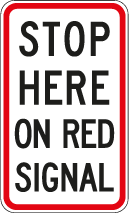W10-5 advance warning signs for traffic signals should be installed in conjunction with flashing red traffic signals.
Where appropriate, W18-5 Fire Station advance warning signs should also be installed in advance of the W10-5 Traffic Signal signs. They should also be used where fire stations and ambulance accesses are located close to an intersection. In this case, the red flashing traffic signals for the fire station should be connected to the signal phasing of the intersection.
Red flashing traffic signals (operating only when called) and requiring drivers to stop can also be installed at other special sites (eg tunnel, quarry access over railway lines etc). A summary of signs is included in Table 11‑1.
Table 11‑1: Flashing red signal signage
| Sign code | Example | Description/use |
|---|---|---|
|
W18-5 Fire station |
 |
Should be installed in advance of an entrance from a fire station where lack of visibility makes it unsafe for the fire appliances to enter the road or highway. It is unsafe to enter the road or highway when from a point 3m back from the edge of the nearest traffic lane the fire appliance driver cannot observe an approaching vehicle on the main route at a distance of at least 180m in rural areas at least 90m in urban areas. The signs should also be used in conjunction with W10-4 traffic signals signs in situations where red flashing traffic signals operate in the vicinity of the fire station and where approaching drivers do not have a clear view of the W10-4 sign over a distance of at least 120m in rural areas and at least 60m in urban areas. For sign location see notes 1 and 2. |
|
W10-4 Traffic signals ahead |
 |
Should also be installed in advance of red flashing traffic signals that are operated on roads approaching tunnels or near fire stations or airfield runways. If pre-warning signs are also warranted, then either W13-6 ‘Road Width or Height Tunnel’ or W18-5 ’Vehicles Crossing fire station’, or W18-2 ‘Vehicles Crossing aeroplane’ signs (as appropriate) should be installed the same distance in advance of the W10-4 sign as the latter is in advance of the signals. When the approach is a one-way road, signs should be installed on both sides. For sign location see notes 1 and 2. |
|
R2-6 Stop on red signal |
 |
May be installed to reinforce the requirement to stop at temporary or part time traffic signals. When used at traffic signals, these signs shall be mounted on the primary traffic signal pole immediately below the traffic signal head. |
|
R2-6.1 Stop on red signal - variable |
 |
May be installed to reinforce the requirement to stop at temporary or part time traffic signals. When used at traffic signals, these signs shall be mounted on the primary traffic signal pole immediately below the traffic signal head. |
|
R2-6.2 Stop here on red signal |
 |
May be installed to reinforce the requirement to stop at temporary or part time traffic signals where the limit line at which vehicles are intended to stop is a distance from the traffic signals. When used at traffic signals, these signs shall be mounted adjacent to the limit line. |
Table 11-1 notes:
The sign should be located where approaching drivers have an uninterrupted view of it over a distance of at least 120m in rural areas and at least 60m in urban areas.
The sign should be installed in advance of the entrance (or W10-4 sign if installed) by at least the distance shown in the table below.
| Operating speed | Distance |
|---|---|
| 50km/h | 65m |
| 70km/h | 100m |
| 80km/h | 120m |
| 90km/h | 140m |
| 100km/h | 160m |